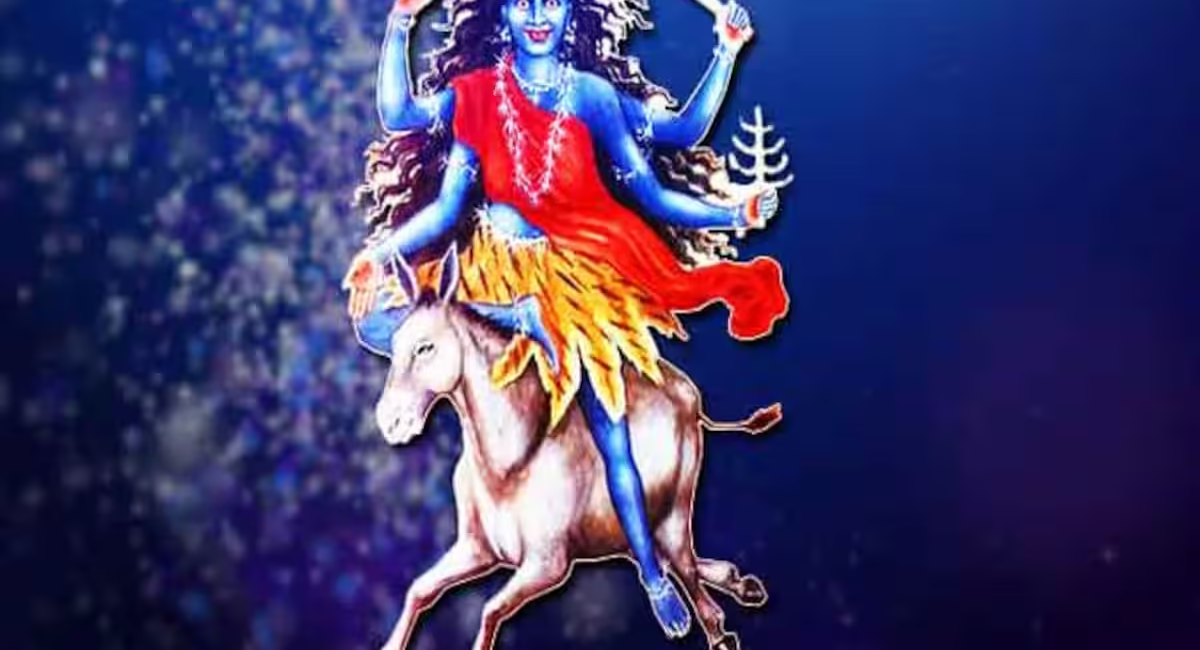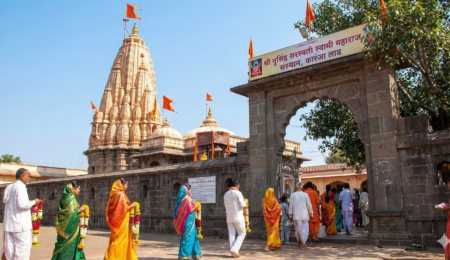Kaalratri – Fierce Form of Durga Worshipped on Navratri Day 7
Introduction to Goddess Kaalratri
Goddess Kaalratri is the seventh manifestation of Navadurga, worshipped on the seventh day of Navratri. She is the fiercest and most transformative form of Durga, representing the power that destroys ignorance, evil, and darkness. Though her appearance is terrifying, she is deeply compassionate and protective, offering liberation and fearlessness to her devotees.
Kaalratri is associated with the Sahasrara Chakra, the crown energy center, which symbolizes pure consciousness and spiritual awakening. Her worship marks a turning point in Navratri, where devotees confront their inner fears and seek divine transformation.
Meaning and Symbolism of the Name ‘Kaalratri’
The name ‘Kaalratri’ is derived from two Sanskrit words:
- Kaal means time or death, representing the eternal cycle of creation and destruction.
- Ratri means night, symbolizing darkness, ignorance, and the unknown.
Together, ‘Kaalratri’ signifies the “dark night of time” or “night of death.” She is the force that dissolves all illusions and attachments, leading the soul toward liberation. Her name reflects her role as the destroyer of evil and the purifier of the soul.
Despite her fearsome form, she is also known as Shubhankari, meaning “the auspicious one,” because her destruction leads to spiritual rebirth and divine grace.
Mythological Background and Birth Story
Kaalratri’s origin is described in several Hindu scriptures, including the Devi Mahatmya, Skanda Purana, and Markandeya Purana. Her manifestation is tied to the cosmic battle between good and evil.
When the demons Shumbha and Nishumbha challenged the gods and seized control of the heavens, Goddess Durga took various forms to defeat them. Among these forms was Kaalratri, who emerged to annihilate the demon Raktabeej.
Raktabeej had a boon that every drop of his blood that touched the ground would create a clone of him. To defeat him, Kaalratri drank his blood before it could fall, preventing his replication and ultimately destroying him.
She also vanquished Chanda and Munda, earning the name Chamunda. Her breath was said to reduce enemies to ashes, and her roar shook the cosmos. In another tale, she emerged from the forehead of Goddess Parvati to destroy the demon Durgamasura.
These stories highlight her role as the ultimate destroyer of evil and the fierce protector of dharma.
Appearance and Iconography
Kaalratri’s iconography is striking and symbolic. Her form evokes both fear and reverence, reminding devotees of the power of divine justice and transformation.
- Complexion: Deep black or blue, symbolizing the infinite void and cosmic dissolution.
- Hair: Disheveled and wild, representing untamed energy.
- Eyes: Three eyes radiating lightning-like rays, representing past, present, and future.
- Nostrils: Emit flames, signifying her fiery power.
- Arms: Four arms—left holds a scimitar and vajra (thunderbolt); right shows Abhaya (protection) and Varada (blessing) mudras.
- Mount: Rides a donkey, symbolizing humility and endurance.
- Ornaments: Garland of skulls, iron anklets, and hibiscus ear ornaments.
Her terrifying form is not meant to instill fear but to destroy ignorance and purify the soul.
Spiritual Significance and Powers
Kaalratri is revered for her immense spiritual powers and transformative energy.
Destruction of Negativity
She annihilates evil forces, demonic energies, and black magic. Her presence purifies the environment and the soul.
Removal of Fear
Her blessings instill courage and resilience. Worshipping her helps overcome phobias, anxiety, and emotional instability.
Awakening of Sahasrara Chakra
She activates the Sahasrara Chakra, leading to spiritual awakening and union with the divine.
Granting Siddhis and Nidhis
She bestows siddhis (spiritual powers) and nidhis (divine treasures), including clairvoyance, healing abilities, and deep spiritual insight.
Her energy is especially beneficial for spiritual seekers and those undergoing intense sadhana.
Connection to Navratri (Day 7) Worship
The seventh day of Navratri, known as Saptami, is dedicated to Kaalratri. This day marks a shift from nurturing to transformative energy.
Rituals and Traditions
- Color of the Day: Blue, red, or grey.
- Offerings: Jaggery, black sesame seeds, mustard oil lamps, and night-blooming jasmine.
- Fasting: Many observe a strict fast, consuming only fruits and water.
- Mantra Chanting: Devotees chant her mantras and stotras.
- Aarti and Bhajans: Special aartis and devotional songs are sung in her praise.
Her worship on this day is believed to remove obstacles and elevate spiritual consciousness.
Associated Mantras and Their Meanings
Om Kaalratryai Namah
- Meaning: Salutations to Goddess Kaalratri.
- Benefits: Removes fear, grants protection, and enhances spiritual strength.
Navadurga Stotra
“Ya Devi Sarvabhuteshu Kaalratri Rupena Samsthita Namastasyai Namastasyai Namastasyai Namo Namah”
- Meaning: Salutations to the goddess who resides in all beings as Kaalratri.
- Benefits: Invokes her presence and purifies the devotee’s mind and soul.
Dhyana Mantra
“Ekaveni Japakarnapura Nagna Khara Sthita Lamboshthi Karnikakarni Tailabhyakta Sharirini Vamapadollasallohalata Kantakabhushana Vardhanamurdhadhwaja Krishna Kaalratri Bhayankari”
- Meaning: A vivid description of her form, used for meditation and visualization.
- Benefits: Deepens spiritual connection and enhances concentration.
Step-by-Step Kaalratri Puja Vidhi
Materials Needed
- Red or black cloth for altar
- Mustard oil lamp
- Incense sticks and camphor
- Blue or red flowers
- Jaggery, coconut, black sesame seeds
- Ganga jal, turmeric, roli, rice grains
- Image or idol of Kaalratri
Puja Procedure
- Cleanse the Space: Clean the puja area and place a red or black cloth on the altar.
- Personal Purification: Bathe and wear clean dark-colored clothes.
- Set Up the Altar: Place the image or idol of Kaalratri and arrange offerings.
- Lighting the Lamp: Light mustard oil lamp and incense sticks.
- Sankalp (Resolution): Take a vow to perform the puja with devotion.
- Mantra Chanting: Recite “Om Kaalratryai Namah” 108 times.
- Offerings: Present flowers, sweets, and sesame seeds.
- Aarti: Perform aarti with camphor while singing devotional songs.
- Meditation: Meditate on her form and visualize her energy.
- Prasad Distribution: Share the prasad with family and guests.
Benefits of Worshipping Kaalratri
Physical Benefits
- Protects from accidents and misfortunes
- Shields against diseases
- Enhances vitality
Mental and Emotional Benefits
- Removes fear and anxiety
- Builds resilience
- Promotes emotional stability
Spiritual Benefits
- Purifies karmic debts
- Awakens higher consciousness
- Facilitates moksha
Life Transformation Stories
Devotees often report overcoming chronic fears, experiencing divine protection, and gaining spiritual insight through her worship.
Regional Variations in Worship Across India
West Bengal
Associated with Kali, worship includes tantric rituals and midnight offerings.
Gujarat
Celebrated through Garba and Dandiya Raas, invoking her energy in dance.
Maharashtra
Revered in Shakta temples with traditional offerings and mantras.
Himachal Pradesh
Worshipped as Mahishasuramardini in temples like Naina Devi and Jwala Ji.
Modern-Day Relevance
In today’s fast-paced and uncertain world, the symbolism of Kaalratri holds profound relevance:
- Facing Inner Demons: She represents the courage to confront our deepest fears, insecurities, and attachments.
- Embracing Change: Her destructive energy clears the path for transformation, helping individuals let go of toxic patterns and evolve.
- Empowering Women: As a fierce feminine force, Kaalratri inspires strength, independence, and fearlessness in women across generations.
- Spiritual Awakening: Her connection to the Sahasrara Chakra encourages seekers to rise above material distractions and attain higher consciousness.
Kaalratri reminds us that darkness is not to be feared—it is a necessary phase before the dawn of enlightenment.
Temples Dedicated to Kaalratri
While Kaalratri is worshipped as part of Navadurga in many temples, a few are especially revered for her presence:
| Temple Name | Location | Unique Feature |
|---|---|---|
| Kaalratri Temple, Varanasi | Uttar Pradesh | Ancient shrine with tantric significance |
| Chamunda Devi Temple | Himachal Pradesh | Associated with her Chamunda form |
| Kalighat Temple | Kolkata, West Bengal | Worshipped as Kali, closely linked to Kaalratri |
| Jwalamukhi Temple | Kangra, Himachal Pradesh | Flame-emitting goddess, fierce aspect |
These temples attract thousands of devotees during Navratri and other auspicious occasions.
Conclusion
Goddess Kaalratri is not just a symbol of destruction—she is the embodiment of divine transformation. Her fierce form teaches us that true growth often requires facing discomfort, shedding illusions, and embracing the unknown. On the seventh day of Navratri, her worship offers a chance to transcend fear, purify the soul, and awaken the highest spiritual potential.
Whether you’re a seeker on the path of enlightenment or someone looking for strength in adversity, invoking Kaalratri can be a powerful step toward inner liberation.




Leave a Comment